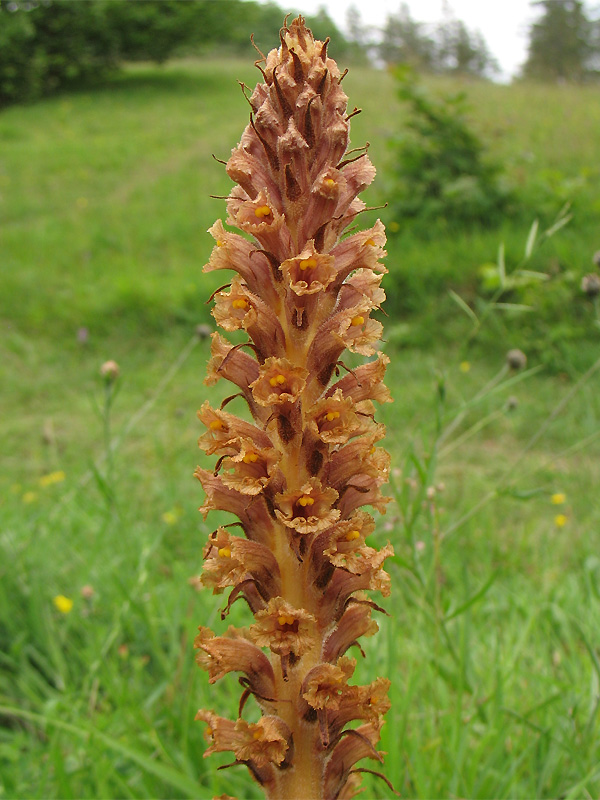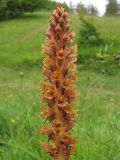
Соцветие (паразитирует на Centaurea scabiosa). ФРГ, земля Nordrhein-Westfalen, округ Euskirchen, заказник Seidenbachtal / Froschberg, луг на выходах известняков. 5 июля 2011 г.
Андрей Ковальчук © 2012
Маркер на карте не будет указывать точные координаты растения или лишайника.
Маркер укажет лишь на условный центр местности ("географической точки"), где сделано фото.
Открыть картуСмотри также:
Обсуждение (6)
Все фото таксона (8)
Код ссылки на фото
| Создать: | HTML или BBCode с "превьюшкой" |
| Код для ссылки в Сети: | |
| Так это будет выглядеть: |  Orobanche elatior на сайте «Плантариум» |
Ссылки для публикаций
Ковальчук А. 2012. Изображение Orobanche elatior Sutton // Плантариум. Растения и лишайники России и сопредельных стран: открытый онлайн атлас и определитель растений. [Электронный ресурс] URL: https://www.plantarium.ru/page/image/id/119446.html (дата обращения: 07.01.2026).
Kovalchuk A. 2012. Image of Orobanche elatior Sutton // Plantarium. Plants and lichens of Russia and neighboring countries: open online galleries and plant identification guide. URL: https://www.plantarium.ru/lang/en/page/image/id/119446.html (accessed on 7 Jan 2026).
Просмотры: 3429Обсуждение
| Холгер Улих | Dear Andrey,
the plant is O. kochii. The habit and the late flowering time are typical for this species. This is the first known place for this species in Germany. Congratulation. Do you have some further details for me to find this plant there in this year? Many thanks. |
| Андрей Ковальчук | Dear Holger,
could you please explain in more details, why do you think that this plant belongs to O. kochii?
I've checked the paper of Jiri Zazvorka on both species, and in my opinion, the plant has all the distinguishing features of O. elatior, i.e. the size (appr. 50 cm), the dense, narrow inflorescence, brownish colour without a tinge of red, regularly curved corolla and narrow long leaves. Concerning the flower time, this specimen was one of the last remaining flowering plants in this population (as it grew in half-shade), while the vast majority of them were becoming withered by the time of my visit.
The population with several dozens of plants was found in the nature reserve Froschberg by Blankenheim in Nordrhein-Westfalen, it is well known to local botanists and some additional information can be even found on internet. |
| Холгер Улих | Dear Andrey,
for the differences between kochii and elatior I've try to send you the detailed account from Dr. J. Zázvorka, but the file is to big for Plantarium. Please send me your mail adress on my mail uhlich.holger@googlemail.com and I will send you the file directly.
My friend Stefan Rätzel has confirmed my revision of yor plant to O. kochii.
Best wishes
Holger |
| Андрей Ковальчук | Dear Holger,
do you mean the paper of Dr. Jiri Zazvorka 'Orobanche kochii and O. elatior (Orobanchaceae) in central Europe' published n Acta Musei Moraviae, Scientiae biologicae (Brno) 95(2): 77–119, 2010? I've checked the paper already, and in my previous post I've listed the features, which in my opinion, allows to determine this plant as O. elatior and distinguish it from O. kochii. I'd greatly appreciate to hear your opinion on them.
By the way, in his paper Dr. J. Zazvorka cites several pictures illustrating O. elatior s. str., and among them the photographs published by Carel Kreutz in his book 'Orobanche: The European Broomrape species. Central and Nothern Europe'. Notably, two of the pictures were made in Nonnenbach, Eifel on 8-7-1988. To me, there is no significant differences between the discussed plant and those shown in the book. Moreover, they likely belong to the same population, as the nature reserve Froschberg is situated between Blankenheim and Nonnenbach. |
| Холгер Улих | Dear Andrey, in our regions, that means Germany, O. kochii grows begin July, distinctly later than O. elatior (begin June). However, I think, that I will visit the place of your find in this year and we will see, if you have explore the first certain occurence of O. kochii in Germany. The question is (and my opinion), if the plants from Carel Kreutz from Nonnenbach are also O. kochii? The flowering time begin Juli (Nonnenbach: 08.07.) is for O. elatior s. str. in Germany to late. |
| Андрей Ковальчук | Dear Holger,
as I already mentioned above, there were only few flowering plants (two or three, if I remember well) at the time of my visit. All other plants in the population (several dozens) were already more or less withered. So, if there are no major differences in phenological events between the last and the current year, I'd say that the coming weekend would be the best time to visit the place.
Additionally, the area is located appr. 500 m above sea level, and its colder climate can explained later flowering time of the species. You can find the detailed description of the area at the following web page:
http://www.nrw-stiftung.de/nafgi/index.php?id=9&area=3
I've also seen plants apparently belonging to the same species in another location in that area, between Nettersheim and Urft. Again, all of them except for a single plant were already withered (July 2, 2011). Please let me know if you'd need exact location of both populations, I can send your the details by mail. |